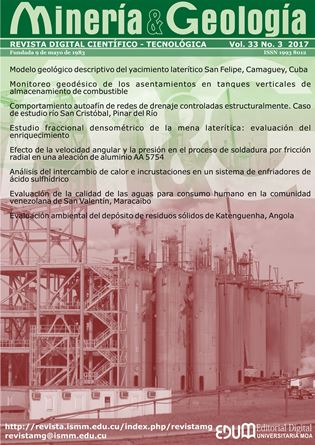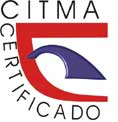Heat Exchange and Fouling Analysis on a Set of Hydrogen Sulphide Gas Coolers
Keywords:
hydrogen sulphide, heat exchanger, jacketed, heat transfer rates, fouling.Abstract
The sulphide acid coolers are tube and shell jacketed heat exchangers designed to cool down the produced gas from 416,15 K to 310,15 K in addition to separate the sulphur carried over by the outlet gas from the reactor tower. The investigation was carried out by applying the passive experimentation process in an online cooler set in order to determine the heat transfer rates and fouling based on heat resistance. It was corroborated that the operation of this equipment outside design parameters increases outlet gas temperature and liquid sulphur carryovers. Efficiency loss is caused by fouling elements in the fluid, which results in changes in the overall heat transfer rate. The linear tendency of the fouling heat resistance based on time for three gas flowrates.Downloads
References
AL-HALLAF, W. A. A. 2013: Theoretical Study on Heat Transfer in the Presence of Fouling. Iraqi Journal of Chemical and Petroleum Engineering. 14(1): 47-53.
ARDSOMANG, T.; HINES, J. W. & UPADHYAYA, B. R. 2013: Heat Exchanger Fouling and Estimation of Remaining Useful Life. En: Annual Conference of Prognostics and Health Management Society. Memorias. Knoxville, Tennessee, Estados Unidos, 1-9.
CHOU, S.; OGDEN, J. M.; POHL, H. R.; SCINICARIELLO, F.; INGERMAN, L.; BARBER, L. & CITRA, M. 2014: Draft Toxicological Profile for Hydrogen Sulphide and Carbonyl Sulphide. U.S. Department of Health and Human Services, Agency for Toxic Substances and Disease Registry, Atlanta, 317 p.
GHIWALA, T. M. & MATAWALA, V. K. 2014: Sizing of triple concentric pipe heat exchanger. International Journal of Engineering Development and Research. 2(2): 1683-1692.
KAKAÇ, S. & LIU, H. 2002: Heat exchangers. Selection, rating and thermal design. 2ed. CRC Press, New York. 491 p.
KERNER, J. 2011: Understanding Fouling. Chemical Engineering. Junio: 35-41.
KIMTANTAS, C. L. & TAYLOR, M. A. 2016: Downsizing a Claus Sulphur Recovery Unit. En: REFCOMM® (Refining Community). Presentación Bechtel Hydrocarbon Technology Solutions Inc. Galveston, Texas, Estados Unidos, 2-6 mayo, 1-36.
LINGE, P. M.; KORANE, A. B. & KAPATKAR, V. N. 2016: Performance Study of Triple Concentric Pipe Heat Exchanger. International Engineering Research Journal (IERJ). Ed. esp., Junio: 629-634.
MUKHERJEE, R. 2004: Practical Thermal Design of Shell-and-Tube Heat Exchangers. Begell House, Inc., Nueva York, 228 p.
PEIGNÉ, P.; INARD, C. & DRUETTE, L. 2013: Ventilation Heat Recovery from Wood-Burning Domestic Flues. A Theoretical Analysis Based on a Triple Concentric Tube Heat Exchanger. Energies. 6(-): 351-373.
RADULESCU, S.; NEGOITA, I. L. & ONUTU, I. 2015: Heat Transfer Coefficient for Hydrocracked Oil Flow in Laminar Regine through an Annular Space. Rev. Chim. (Bucarest). 66(1): 83-87.
SAURABH, D.; TAMKHADE, P. K. & LELE, M. M. 2016: Design Development and Heat Transfer Analysis of Triple Concentric Tube Heat Exchanger. International Journal of Current Engineering and Technology (IJCET). 5 :246-251.
TEMA. Standards of the Tubular Exchanger Manufacturers Association. TEMA, 9na ed. Nueva York: Tubular Exchanger Manufacturers Association, Inc., 2007.
THOME, J. R. 2010: Chapter 3 Single-Phase Shell-Side Flows and Heat Transfer. En: THOME, J. R. Engineering Data Book III. Wolverine Tube, Inc., Laussanne, Switzerland, 3-1–3-13.
TORRES-TAMAYO, E.; QUINTANA-CHARLOT, L. E.; VEGA-ÁRIAS, O. & RETIRADO-MEDIACEJA, Y. 2011: Coeficientes de transferencia de calor y pérdida de eficiencia en intercambiadores de calor de placas durante el enfriamiento del licor amoniacal. Minería y Geología. 27(2):67-83.
UNITEL. 2016: Hydrogen Sulphide (H2S) Production Technology. Unitel Technologies [en línea]. Consulta: 19 dic 2016. Disponible en: http://www.uniteltech.com/_literature_182468/Hydrogen_Sulfide_(H2S)_Production_Technology
YOUNGER, A. H. 2004: Sulphur Recovery. En: YOUNGER, A. H. Natural Gas Processing Principles and Technology – Part II. University of Calgary, Alberta. pp. 20-1–20-60.
Published
How to Cite
Issue
Section
Copyright (c) 2017 Andrés Adrian Sánchez-Escalona, Ever Góngora-Leyva, Carlos Zalazar-Oliva, Edel Álvarez-Hernández

This work is licensed under a Creative Commons Attribution-NonCommercial 4.0 International License.
- Authors retain copyright and guaranteeing the right magazine to be the first publication of the work as licensed under a Creative Commons Attribution-NonCommercial that allows others to share the work with an acknowledgment of the work's authorship and initial publication in this journal.
- Authors may establish separate supplemental agreements for the exclusive distribution version of the work published in the journal (eg, place it in an institutional repository or publish it in a book), with an acknowledgment of its initial publication in this journal.
- Authors are allowed and recommended to disseminate their work through the Internet (e.g., in institutional telematic archives or on their websites) before and during the submission process, which can produce interesting exchanges and increase citations of the published work. (See The effect of open access)










